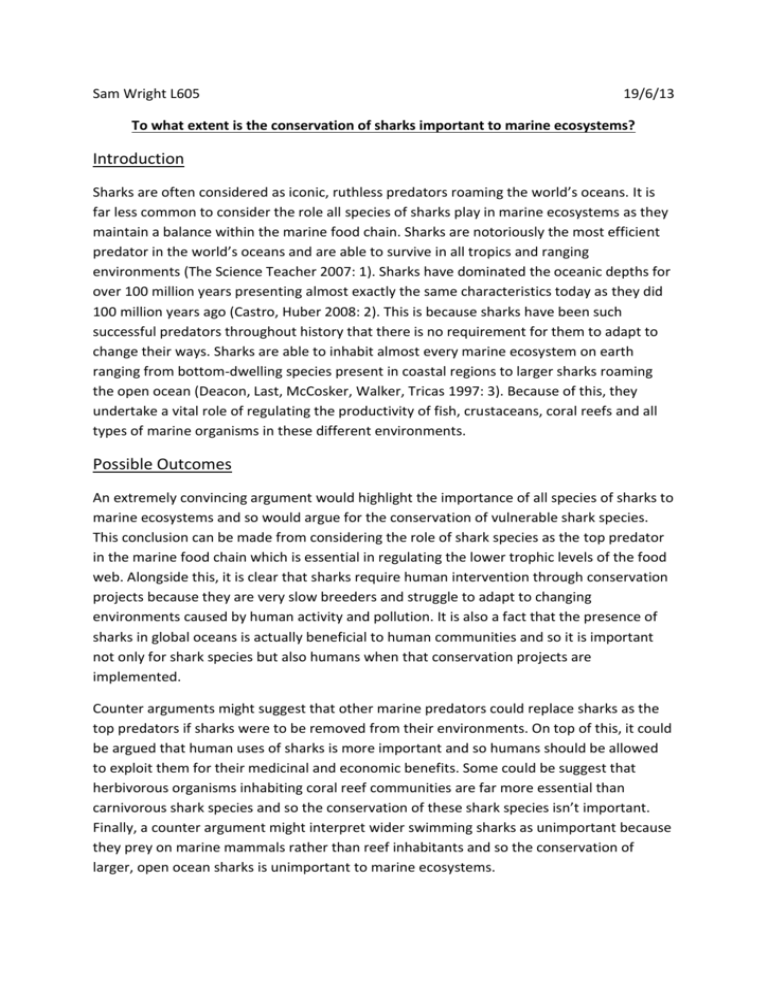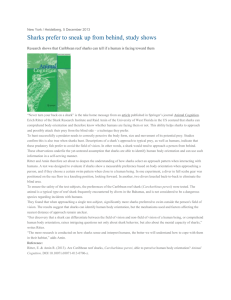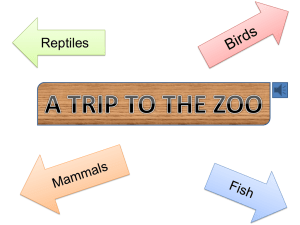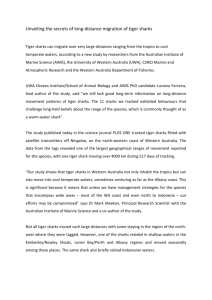epq essay – sharks
advertisement

Sam Wright L605 19/6/13 To what extent is the conservation of sharks important to marine ecosystems? Introduction Sharks are often considered as iconic, ruthless predators roaming the world’s oceans. It is far less common to consider the role all species of sharks play in marine ecosystems as they maintain a balance within the marine food chain. Sharks are notoriously the most efficient predator in the world’s oceans and are able to survive in all tropics and ranging environments (The Science Teacher 2007: 1). Sharks have dominated the oceanic depths for over 100 million years presenting almost exactly the same characteristics today as they did 100 million years ago (Castro, Huber 2008: 2). This is because sharks have been such successful predators throughout history that there is no requirement for them to adapt to change their ways. Sharks are able to inhabit almost every marine ecosystem on earth ranging from bottom-dwelling species present in coastal regions to larger sharks roaming the open ocean (Deacon, Last, McCosker, Walker, Tricas 1997: 3). Because of this, they undertake a vital role of regulating the productivity of fish, crustaceans, coral reefs and all types of marine organisms in these different environments. Possible Outcomes An extremely convincing argument would highlight the importance of all species of sharks to marine ecosystems and so would argue for the conservation of vulnerable shark species. This conclusion can be made from considering the role of shark species as the top predator in the marine food chain which is essential in regulating the lower trophic levels of the food web. Alongside this, it is clear that sharks require human intervention through conservation projects because they are very slow breeders and struggle to adapt to changing environments caused by human activity and pollution. It is also a fact that the presence of sharks in global oceans is actually beneficial to human communities and so it is important not only for shark species but also humans when that conservation projects are implemented. Counter arguments might suggest that other marine predators could replace sharks as the top predators if sharks were to be removed from their environments. On top of this, it could be argued that human uses of sharks is more important and so humans should be allowed to exploit them for their medicinal and economic benefits. Some could be suggest that herbivorous organisms inhabiting coral reef communities are far more essential than carnivorous shark species and so the conservation of these shark species isn’t important. Finally, a counter argument might interpret wider swimming sharks as unimportant because they prey on marine mammals rather than reef inhabitants and so the conservation of larger, open ocean sharks is unimportant to marine ecosystems. Sharks’ role as the top marine predators The most well-known and feared shark is the Great White (Carcharodon carcharias). It is considered the most dangerous to humans out of all the species of sharks. However, dangerous, carnivorous sharks such as the Great White and others alongside it such as bull (Carcharhinus leacuas) and tiger (Galeocerdo cuvier) sharks also play key roles in regulating marine ecosystems and without them, the balance of predation and prey in the oceans would be terribly unbalanced. These larger, carnivorous sharks feed on marine mammals and fish of the sea such as seals, dolphins, turtles as well as seabirds and sea lions (Beer, Hall 2007: 4). The feeding patterns of large sharks such as the Great White allow a constant flow of energy throughout the marine food chain. As shown in the diagram on the left (NOAA 2010: 5), large sharks are the top predator in the marine food web. This allows each consumer lower in the web to feed on their prey in order to gain energy which allows body processes such as respiration to occur. For example; sunlight provides energy for the single-celled organisms, these organisms provide energy for shrimplike creatures once eaten, as small fish consume these creatures they uptake the energy previously gained. The process continues and results in the large shark gaining the most energy by consuming the large fish – which it requires in order to survive and breed. Without the presence of the large shark as the primary consumer/ top predator, the balance of the food chain is unequal – resulting in an increase in the number of large fish. This would create an abundance of larger fish such as mackerel and tuna predating on small fish to such an extent those populations of these smaller fish could reduce exponentially. In turn, this means the energy flow is unbalanced as the larger fish begin to run out of a food source. This obviously creates a problem and highlights the importance of the primary consumer and top predator in this food chain. Following this, it seems feasible to question why there isn’t an overload of large sharks in the marine food chain since nothing in the sea hunts them. From this it would seem logical to suggest that sharks don’t need help from humans via conservation projects. However this would be wrong since humans have overhunted and exploited large sharks for their fins, teeth, skin and through game fishing to such an extent that large, iconic sharks such as the Great White and Basking shark (Cetorhinus maximus) are listed as endangered and vulnerable on the IUCN Red List (Beer, Hall 2007: 4). Human demand for ‘shark fin soup’ has heavily increased since the turn of the century in countries such as China which have profited from a growing economy. A bowl of high quality ‘shark fin soup’ can cost up to $720.37 (Martin 2007: 6) which demonstrates why sharks have been overexploited for their fins. This exploitation of sharks by humans affects not only the largest, dangerous sharks but also passive unaggressive species such as the Great Hammerhead Shark (Sphyrna mokarran) and Whitetip Reef sharks (Carcharhinus longimanus) which are helpless to human exploits and have been labelled as ‘Threatened’ on the IUCN Red List as a result (Beer, Hall 2007: 4). In return, it is essential that humans put forward conservation efforts to try and restore the balance of sharks in the Earth’s oceans since their decline has largely been caused by human activity. Alongside this, sharks are naturally slow to reproduce which limits their ability to adapt to changing environments quickly. Shark reproductive systems are more similar to that of mammals rather than that of other fishes. The gestation period inside a female shark may take up to 2 years after which they lay only a few large eggs to be fertilised by male sperm (Deacon, Last, McCosker, Walker, Tricas 1997: 3). Great White sharks have the lowest reproduction rate of all the large sharks and have an infant mortality rate as high as 80% which causes serious problems for this species (Deacon, Last, McCosker, Walker, Tricas 1997: 3). Due to Great White sharks’ slow reproductive rates, even slight changes in their environment can have dramatic consequences for their population (Martin 2007: 6). Therefore it is essential that humans intervene in order to help protect vulnerable species such as the Great White. Promising initiatives such as the IUCN Red List and Appendix II (CITES) have emplaced restrictions on the killing and trade of white sharks in order to protect the species (IUCN Red List 2013: 7). The IUCN Red List details all species of all organisms and labels which of each is endangered/vulnerable/threatened/extinct and so on. This ‘list’ enables conservation efforts to be put in place to restrict human exploitation of these endangered species. The Appendix II put forward by CITES (Convention on International Trade in Endangered Species) represents an effective way to enforce restrictions and protection for endangered species (CITES 2013: 8). As a result of these initiatives the White shark is fully protected in Australian, U.S, South African, Maltese and Namibian waters (Bruce 2008: 9). Even so, this success for the protection of White sharks needs to be implemented globally for all species of vulnerable sharks that require human conservation efforts. Other than being notorious for their predation skills, sharks – especially reef sharks, undertake the role of regulating marine life in environments such as coral reefs. This is an extremely important concept in allowing a balance within marine ecosystems since without the presence of smaller, reef sharks such as the Nurse shark (Carcharias taurus); the food chain would become completely overturned resulting in the destruction of the coral reef. The Nurse shark is one of millions of the fish abundant on coral reefs including many other sharks. The Nurse shark prospers in the shallow waters (up to 50m) of tropic continents such as Brazil, Mexico and the Caribbean feeding on crabs, fish and crustaceans (Beer, Hall 2007: 4). By doing so, this species of shark ensures that the reef doesn’t become overpopulated with ‘browsers’ which feed on and damage the coral reef. Without the presence of the Nurse shark, the prey could be free from predation and would very quickly overpopulate the reef and cause irreversible damage to it. Effects of removing sharks as the top predators This concept was highlighted in 1974 at the Great Barrier Reef in Australia with the introduction of the ‘crown-of-thorns’ starfish. This species of starfish populated a section of the reef in which there were no predators to feed on it. This allowed the starfish to freely roam the reef consuming whatever parts of the reef it wanted. In doing so the starfish was found to have caused 95% mortalities to the coral reef it inhabited once it was removed from the site (Wood 1999: 10). This mortality rate of 95% represents mass destruction of the reef as almost the whole reef this starfish inhabited was subject to damage. This mortality rate reached such a high percentage because there was no predation effecting the ‘crown-of-thorns’ starfish population. The starfish population was allowed to prosper and overpopulate its section of reef and in doing so, destroy their own habitat (Wood 1999: 10). This highlights the fact that predators such as sharks are essential to maintaining a healthy and prosperous living environment on reefs as they regulate the populations of marine ‘browsers’ that are likely to negatively affect the ecosystem of the reef. Other examples of the negative effect of removing sharks as the top predators in the food chain have been highlighted in South Africa and Tasmania during the 1970s and 80s (Nicholls 2012: 11). In South Africa, large-meshed nets were erected in order to catch large sharks. This allowed a huge increase in the abundance of smaller shark species such as Thresher (Alopias vulpinus) and Whitetip reef (Carcharhinus longimanus) sharks which overfed on small fish species causing a huge decline in population numbers. This is terribly problematic for both marine communities as well as human communities which rely on an abundant supply of small fish to provide food and jobs which fuels the local economy. This therefore highlights the importance of the presence of large sharks in marine communities which are essential for controlling the populations of smaller shark species. Similarly in Tasmania, a shark fishery was blamed for the collapse of a neighbouring crayfish farm (Nicholls 2012: 11). The removal of predatory sharks by the fishery had allowed populations of octopuses to prosper which sought after the crayfish farms’ crayfish which caused the farm to collapse. Octopus is popular prey for smaller, reef sharks such as the Nurse shark (Beer, Hall 2007: 4) and so without the presence of species of sharks such as this, octopus populations were allowed to prosper exponentially. Once again, the importance of predatory sharks is highlighted by this example of the destruction caused as a result of removing them from an environment. The example of Tasmania also emphasises the importance of sharks to human communities. Scripps Institution of Oceanography Investigation In 2005, the Scripps Institution of Oceanography of the University of California observed a very interesting change in behaviour of prey fish when sharks are removed from the ecosystem (Nicholls 2012: 11). At the Line Islands in the Pacific Ocean scientists compared marine ecosystems of two different coral reef communities. Reefs which had the least amount of human disturbance portrayed the healthiest communities and supported the greater biomass of fish due to a vast abundance of predatory sharks. In comparison, reefs which had been subject to human disturbance removing sharks showed a far unhealthier and unproductive community. Sheila Walsh of the Nature Conservancy based in Virginia stated that “it doesn’t seem energetically possible” (Nicholls 2012: 11). Scientists concluded that the absence of predatory sharks caused prey fish to mate and develop at a far slower rate which resulted in a less productive reef system. Walsh also suggests that “having sharks around makes for faster, more productive fisheries” which defies the simple assumption that removing the top predator will allow a greater population of prey fish (Nicholls 2012: 11). From these findings it is evident that sharks play a crucial role in maintaining a healthy, functional marine community and without the exploitation of humans, coral reefs are able to naturally prosper. It seems that prey fish are reliant on the presence of predatory shark species in order to mate and develop at a fast rate. Without the presence of predatory sharks, the prey fish were described as being “consistently fatter” upon dissection it was seen that their “intestines were lined with fat” (Nicholls 2012: 11). In comparison, prey fish at sites undisturbed by humans were described as “slender” which coincided with a more productive coral reef community. The results of this investigation comprehensively reveal how essential to all types of marine life the presence of sharks is and illustrates why conservation of vulnerable sharks is a vital practise. It is obvious from the evidence provided by the Scripps Institution of Oceanography that sharks are extremely important components to marine ecosystems. As Sheila Walsh indicates, there are also benefits for humans when considering shark conservation projects (Nicholls 2012: 11). The experiment detailed by the Scripps Institution of Oceanography reveals how the presence of shark species allows fisheries of both fish and invertebrates such as crayfish to be far more productive. In turn, this allows local fishermen to access a greater abundance of fish in order to feed local communities. This not only benefits them personally but would also boost the local economy which obviously is a huge bonus. Therefore, it is not only in the interest of marine ecosystems that sharks are present but is also hugely beneficial for human communities. This evidence clearly supports the implementation of conservation projects to protect threatened sharks and would appeal to a vast human audience because of the incentives provided by marine communities populated with sharks. Basking and Whale Sharks Furthermore, different shark species show diverse feeding patterns which allow them to prey on almost all creatures found in the sea. The largest sharks in today’s oceans are the Whale (Rhincodon typus) and Basking sharks (Cetorhinus maximus) which peculiarly feed on the smallest groups of organisms found in the ocean – plankton. A “plankton soup” is made up of very tiny floating plants and animals which are unable to forcibly swim against the water current (Pope 2002: 12). Most of these tiny animals are in fact larvae (eggs) of smaller fish, crustaceans and other small, marine organisms. Basking sharks filter through 1800 tonnes of water every hour to collect their plankton meal. This feeding process contributes to the regulation of the population growth of smaller organisms as they are consumed before they are able to develop into fully grown adults. This again highlights the role of sharks as regulators of marine life. Even though large sharks such as the Basking and Whale sharks don’t actively hunt their prey, they do contribute greatly to controlling the population growth of smaller marine organisms. From this, it is clear to see the importance of not only smaller, bottomdwelling sharks but the largest sharks to marine ecosystems because of their feeding patterns. Once again, the conservation of all species of sharks is vitally important in restoring the balance of marine communities as shown by the diet patterns of even the largest, less predatory sharks. Replacing sharks as the top predator However, an alternative interpretation would argue that the shark’s role in the marine community isn’t important enough for human intervention through conservation projects. This argument relies on the assumption that other marine predators will replace the shark as the top, dominant predator throughout the world’s oceans. For example, killer whales appear as a sensible replacement for large, carnivorous sharks because they exhibit a similar diet. Killer whales are active predators that feed on a wide variety of fishes along with marine mammals such as seals, sea lions, baleen whales, penguins and sea otters (SeaWorld 2013: 13). In comparison to large, predatory sharks such as the Great White, killer whales present almost exactly the same diet. Alongside this, the killer whale is currently ranked as the largest predator of warm-blooded animals alive today. This would suggest that killer whales could be the perfect replacement for large sharks as the top predator in the sea. However, the diagram on the right represents the global distribution of killer whales as highlighted by the dark yellow print. The diagram depicts a very limited expanse of sea covered by killer whales (Vancouver Aquarium Cetacean Research Program 2011: 14). For this reason, it is implausible to suggest that killer whales could replace large sharks as the dominant predators of the ocean because they patrol such a limited proportion of the sea in comparison to that by large predatory sharks which roam the open ocean globally. Furthermore, the diversity of top predatory shark species such as Great White, Bull, Tiger and Lemon sharks heavily outnumber killer whale populations and distributions. For this reason the interpretation that sharks aren’t important because they can be replaced is clearly flawed. It is not only large predatory sharks that would need to be replaced but also bottomdwelling sharks that roam coastal habitats at shallower waters. It could be argued that these bottom-dwelling sharks would be easier to replace since coral reefs are so abundant with fish. For example; barracuda, octopuses, stingrays and blue marlins are just a handful of predatory fish that inhabit coastal regions, regulating coral reefs for their prey. Between octopuses and stingrays they consume prey such as fish, crustaceans, shrimp, molluscs which are hugely abundant on coral reefs (National Geographic 2013: 15). In contrast, blue marlin and barracuda tend to predate on larger reef fish growing up to their own size as well as mackerel and tuna stretching further outward towards the open sea. Therefore it could be suggested that coastal sharks such as the Whitetip reef shark, Grey reef shark (Carcharias taurus) and Nurse shark would be easily replaced by these other reef predators. Although this may appear plausible, if these predators took dominance there would be nothing to predate on them in order to limit their population growth as demonstrated by the Tasmanian example of octopuses causing the destruction of a neighbouring crayfish farm. The ecosystem which may appear balanced at first, would soon become unbalanced with an overpopulation of these predators and an under population of bottom-dwelling organisms as the predators are likely to over-exploit the abundance of fish and crustaceans on the reef. In contrast, sharks are incapable of becoming overpopulated because of their inability to reproduce quickly due to the gestation period in female shark species usually lasting at least 2 years. Sharks are therefore essential to the marine community in order to prey on these secondary predators as a way to restrict their population growth. Without the presence of sharks, there would be no predators large enough to hunt barracuda, octopuses, stingrays etc efficiently enough which would result in a terribly unbalanced marine food web. Medicinal uses from sharks Some may argue that even though sharks may be important to marine ecosystems, they have a greater importance in relation to human use. The most essential human benefit from sharks is for their medicinal use. Sharks are immune to almost all types of disease due to a chemical called ‘squalene’ present in their liver oil which prevents harmful illnesses such as cancer from affecting their vital organs (Pope 2002: 12). Alongside squalene, shark oils contain chemicals which can control cholesterol levels which is a major cause of cardiovascular disease in humans. A specific species of shark named the Spiny Dogfish (Squalus acanthias) produces liver oils containing 10 times the amount of vitamin A than that of cod liver oils (Pope 2002: 12). It could be argued that because of sharks’ production of such valuable and useful oils which can be put to great use by humans; they become more important for human use than their respective roles in marine ecosystems. Furthermore, shark oils can have great use during medical operations as they can be used as anticoagulants during heart surgery in order to stop the clotting of blood. It is able to be used in this way because it suppresses the enzyme activity of thrombin which would convert soluble fibrinogen into insoluble fibrin; causing the blood to clot. Moreover, dried shark brain acts as a general pain killer and can prevent tooth decay (Pope 2002: 12). On top of this, shark corneas have successfully been used in human transplant operations along with shark cartilage which can create a synthetic skin to treat burn victims (Pope 2002: 12). Therefore, it could be proposed by some that human medicinal uses for sharks are more important than their roles within their own marine environments. However, it would be far more intelligent to conserve and protect shark species in order to create a sustainable source of these medicinal properties for continual human use. If sharks are over-exploited now, humans would benefit from their uses for a short period of time until they become extinct along with the source of such medical properties. Therefore, it is far more suitable to implement conservation initiatives in order to create a sustainable population of vulnerable shark species and in doing so, create a sustainable supply of medicinal products from which humans would benefit to a far greater extent over many generations. Role of Herbivores on the reef An alternative argument also puts forward the idea that herbivores may be more influential to the productivity of coral reefs in comparison to carnivorous predators such as sharks (Wood 1999: 10). Herbivorous organisms are essential to coral reef productivity as they facilitate the flow of energy to higher trophic levels within the marine food web (Wood 1999: 10). As depicted by the food web on the right, herbivores, crustaceans and molluscs make up the middle three sections ranging from trophic levels 2 to 4 (World Aquaculture 2000: 16). Without this foundation, the carnivorous “finfish” placed in the top trophic level (level 5) would be without prey and would struggle to survive as a result. From this, it can be concluded that the herbivorous foundation is essential to carnivorous sharks’ survival. It could also be argued that herbivorous organisms are able to prosper without the presence of predatory sharks whereas the opposite is not possible. Therefore some may suggest that sharks are not in fact essential to marine communities but herbivorous organisms rather are more essential in creating a productive coral reef community. This is because the foundation trophic level populations of herbivorous organisms such as crustaceans and molluscs are able to continue surviving even in the absence of carnivorous “finfish”. Moreover, it could be argued that sharks aren’t important to marine ecosystems because herbivorous organisms promote a high level of productivity on reefs as they regulate algae and micro-organisms by feeding on the most abundant species of each (Wood 1999: 10). This enables a greater biodiversity and species evenness within the marine community as many different species of algae and micro-organisms are allowed to grow without one species dominating the reef community. Dominant species of micro-organisms are prevented from thriving because of the feeding nature of herbivorous reef organisms which creates a greater opportunity for subordinate and opportunist species to grow instead (Wood 1999: 10). From this, some may argue that reefs would be just as productive without the presence of predatory sharks because of the niche (role) performed by herbivorous organisms. However, it is far more convincing to realise that both herbivorous and carnivorous marine organisms can survive in unison within the ecosystem because they undertake such diverse niches. Carnivorous and herbivorous organisms don’t compete with each other for shelter/food/mates and so the existence of one does not restrict the existence of the other. A reef which inhabits both carnivorous species such as sharks and herbivorous marine creatures would definitely be far more productive and healthy than a reef which solely consists of herbivorous species (Wood 1999: 10). Therefore, it isn’t a sensible conclusion to believe that sharks aren’t important to marine communities just as it would be implausible to suggest that herbivorous creatures are unimportant in the same way. Unimportance of large sharks A final interpretation that may be put forward is to suggest that larger sharks that roam the open ocean are less important to marine ecosystems because they inhabit environments so far from coastal reefs and communities. Large predatory sharks such as the Great White which feed on marine mammals such as sea lions and seals don’t necessarily contribute to the marine food chain since its prey mammals can inhabit landed shores as well as the ocean. It is clear that reef and coastal sharks provide an essential function to marine communities by regulating browsing species of fish and crustaceans in order to allow a productive reef. However, it could be argued that the role of larger predatory sharks isn’t as essential as that of smaller, reef sharks. Therefore, it may seem acceptable to discourage conservation projects aimed at protecting these larger sharks which supposedly have very little impact on the marine ecosystem. In response to this argument, it is essential to consider the diversity of predatory shark species. As previously mentioned; different shark species are able to inhabit completely contrasting marine environments and impact the local ecosystem in their own community. For example, Bull sharks regularly enter estuaries and fresh water rivers in search for mates in order to breed (Pope 2002: 12). This is why the Bull shark is so dangerous to humans because it regularly enters fresh waters in which humans are more likely to be present. This species represents just one example of the diversity displayed by most sharks as they can prosper in almost every marine environment available to them. Because of this, large predatory sharks tend to feed on most of the large fish and marine mammals they interact with. Once again, this illustrates how large predatory sharks affect marine ecosystems as they feed on prey labelled as being in the top trophic levels in the marine food web. Therefore, these sharks are also incredibly important to the marine food chain as a means of regulating the predators in the trophic level below theirs. This illustrates that there is also a need to conserve and protect large predatory shark species not only because they are fascinating creatures but because of their importance in relation to the diverse marine communities they interact with. To what extent are sharks important to marine ecosystems? It could be argued that the conservation of sharks is not important to marine ecosystems firstly because of their potential replacement by other predatory species such as killer whales, barracuda and blue marlin. Along with this some may argue that marine herbivores would allow coral reefs to prosper to a similar extent as is possible in the presence of predatory sharks. It could also be suggested that the human uses of sharks as medicine and in medical operations is far more important than their relative importance to marine communities. On top of this, it is possible to argue that large sharks are relatively unimportant to marine ecosystems and so conservation efforts towards protecting such species are unnecessary. However, a far more convincing interpretation would realise that all types of species of sharks are extremely important to marine ecosystems and because of this they do require conservation efforts in order to protect them. It is evident that coral reefs are far more productive in the presence of reef sharks which feed on ‘browser’ organisms to prevent the destruction of the reef. This was highlighted through the examples detailed by the Scripps Institution of Oceanography at the University of California, the fishery in South Africa as well as the crayfish farm example in Australia (Tasmania). The argument that vulnerable sharks should definitely be conserved is further supported because of the incentives for humans as a result of this. As suggested by Sheila Walsh – following the findings from the Scripps Institution of Oceanography at the University of California investigation, fishermen benefit hugely from shark presence nearby fisheries because they remove predators that would restrict the abundance of smaller fish. Furthermore, humans would benefit from a sustainable supply of shark oils to use for medicinal purposes for future generations which is obviously an incredible incentive for supporting conservation projects aimed at protecting sharks. The interpretation that sharks are unimportant to marine ecosystems can be dismissed by highlighting the limitations of this argument. The assumption that other marine predators showing similar diet patterns to sharks have the capabilities to replace them as the ‘top’ predator is simply an assumption and the evidence collected from South Africa, Tasmania and California suggest that the absence of sharks leads to a major imbalance of the food chain within a marine community. Therefore it is clear that sharks are an incredibly important asset to marine ecosystems throughout all environments in today’s oceans and because of this, it is essential that humans implement conservation projects in order to help protect and save these assets. References (in order of appearance): 1. The Science Teacher (2007). Sharks’ Bite Force (article). 2. Peter Castro, Michael E. Huber (2008). Marine Biology pgs. 144-157: McGraw-Hill Higher Education (book). 3. Kevin Deacon, Peter Last, John E. McCosker, Terence I. Walker, Timothy C. Tricas (1997). Sharks & Rays pgs. 104-107: Collins (book). 4. Amy-Jane Beer, Derek Hall (2007). The Illustrated World Encyclopaedia of Marine Fish and Sea Creatures pgs. 156-159: Lorenz Books (book). 5. (http://teacheratsea.wordpress.com/tag/food-chain/). NOAA (National Oceanic and Atmospheric Administration) 2010 – (picture). 6. Julie B. Martin (2007). The Price of Fame: CITES Regulation and Efforts towards International protection of the Great White Shark: George Washington University (article). 7. (http://www.iucnredlist.org/details/3855/0). IUCN Red List (International Union for Conservation of Nature) 2013 – (picture). 8. (http://www.cites.org/eng/app/). Convention on International Trade in Endangered Species of Wild Fauna and Flora 2013 (web source). 9. Barry D. Bruce (2008). Chapter 5 – Biology and Ecology of the White Shark (Sharks of the Open Ocean: Biology, Fisheries and Conservation) pgs. 69-76: Blackwell Publishing Ltd (book/article). 10. Rachel Wood (1999). Reef Evolution pgs. 260-264: Oxford University Press on Demand (book). 11. Henry Nicholls (2012). Swimming into the Oblivion: PLOS BIOLOGY (article). 12. Joyce Pope (2002). 1001 Facts about Sharks pgs. 80-81, 94-95, 139: Backpack Books (book). 13. (http://www.seaworld.org/animal-info/info-books/killer-whale/diet.htm). SeaWorld 2013 (web source). 14. (http://killerwhale.vanaqua.org/page.aspx?pid=1355). Vancouver Aquarium Cetacean Research Program 2011 (picture). 15. (http://animals.nationalgeographic.co.uk). National Geographic 2013 (picture). 16. (http://www7.taosnet.com/platinum/data/environment/destruction.html) World Aquaculture 2000 (picture).






